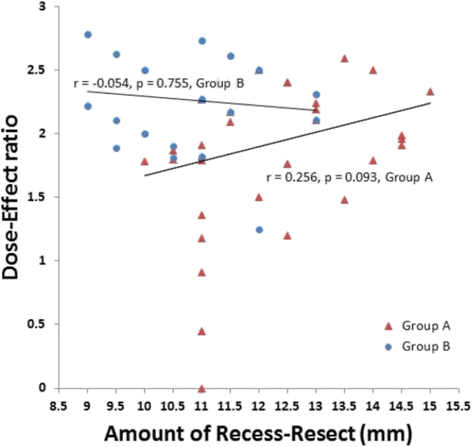Comparison of outcomes of unilateral recession-resection as primary surgery and reoperation for intermittent Exotropia
- PMID: 28679404
- PMCID: PMC5499031
- DOI: 10.1186/s12886-017-0512-5
Comparison of outcomes of unilateral recession-resection as primary surgery and reoperation for intermittent Exotropia
Abstract
Background: The aim of this study was to compare the primary surgery and reoperation outcomes of unilateral lateral rectus recession and medial rectus resection (R&R) for intermittent exotropia.
Methods: We retrospectively reviewed the medical records of 80 patients, all of whom had undergone unilateral R&R for intermittent exotropia as a primary surgery or reoperation and been followed-up on postoperatively for 6 months or more. The patients were divided into two groups: unilateral R&R as primary surgery (group A, 44 patients) and unilateral R&R as reoperation (group B, 36 patients). The outcome measures were postoperative angle of deviation, surgical success rate, and mean dose-effect ratio (PD/mm, corrected angle of deviation / sum of amount of recession of lateral rectus and of resection of medial rectus). Surgical success was defined as exo- or esodeviation within 8 PD.
Results: The mean postoperative follow-up duration was 49.91 ± 14.83 months in group A and 43.17 ± 26.91 months in group B (p = 0.160). The mean angles of deviation at postoperative 1 day were -5.18 PD (overcorrection) in group A and -5.28 PD in group B (p = 0.932). However, there was a significant difference in the mean angle of deviation between the two groups at each visit from postoperative 3 months to final follow-up (p < 0.05): in short, group A had become more exotropic than group B. And the surgical success rate was higher in group B than in group A at each visit from postoperative 12 months to final follow-up (47.7% in group A and 83.3% in group B at final follow-up) (p < 0.05). The mean dose-effect ratio at 6 months after surgery was 1.89 ± 0.58 PD/mm in group A and 2.26 ± 0.32 PD/mm in group B (p = 0.001).
Conclusions: Unilateral R&R as reoperation presented better results for the surgical treatment of recurrent exotropia, showing a smaller exodrift pattern and higher surgical success rates compared with R&R as a primary surgery. The mean effect per millimeter (the mean dose-effect ratio, PD/mm) of R&R as reoperation was significantly greater than that of R&R as primary surgery at postoperative 6 months. These results could serve as useful guidelines in the planning of surgical correction for primary and recurrent exotropia.
Keywords: Dose-effect ratio; Intermittent exotropia; Surgical success rate; Unilateral recession-resection.
Conflict of interest statement
Ethics approval and consent to participate
This study was conducted according to the tenets of the Declaration of Helsinki and was approved by the Institutional Review Board of the Hallym University Medical Center (2014–12-176).
Consent for publication
Not applicable.
Competing interests
Neither of the authors (Young Bok Lee or Dong Gyu Choi) has any potential conflicts of interest (i.e. no relevant financial interests, activities, relationships or affiliations).
Publisher’s Note
Springer Nature remains neutral with regard to jurisdictional claims in published maps and institutional affiliations.
Figures
Similar articles
-
Outcome of two-muscle surgery for large-angle intermittent exotropia in children.Br J Ophthalmol. 2017 Apr;101(4):462-466. doi: 10.1136/bjophthalmol-2016-308736. Epub 2016 Jun 30. Br J Ophthalmol. 2017. PMID: 27364773
-
Reduction of Consecutive Esotropia Using Modified Contralateral Recession and Resection for Recurrent Intermittent Exotropia.J Pediatr Ophthalmol Strabismus. 2018 Jan 1;55(1):53-58. doi: 10.3928/01913913-20170703-06. Epub 2017 Oct 9. J Pediatr Ophthalmol Strabismus. 2018. PMID: 28991342
-
Long-term outcomes following resection-recession versus plication-recession in children with intermittent exotropia.Br J Ophthalmol. 2020 Mar;104(3):350-356. doi: 10.1136/bjophthalmol-2018-313711. Epub 2019 May 22. Br J Ophthalmol. 2020. PMID: 31118183
-
Bilateral lateral rectus recession versus unilateral recession resection for basic intermittent exotropia: a meta-analysis.Graefes Arch Clin Exp Ophthalmol. 2018 Mar;256(3):451-458. doi: 10.1007/s00417-018-3912-1. Epub 2018 Jan 24. Graefes Arch Clin Exp Ophthalmol. 2018. PMID: 29368040 Review.
-
Efficacy of bilateral lateral rectus recession versus unilateral recession and resection for basic-type intermittent exotropia: a meta-analysis.Acta Ophthalmol. 2021 Nov;99(7):e984-e990. doi: 10.1111/aos.14726. Epub 2021 Feb 11. Acta Ophthalmol. 2021. PMID: 33576184
Cited by
-
Extraocular muscle resection, recession length and surgery outcome modelling in strabismus treatment: a pilot study.BMJ Open Ophthalmol. 2021 Nov 5;6(1):e000802. doi: 10.1136/bmjophth-2021-000802. eCollection 2021. BMJ Open Ophthalmol. 2021. PMID: 34796269 Free PMC article.
References
-
- Jenkins RH. Demographic geographic variations in the prevalence and management of exotropia. Am Orthop J. 1992;42:82–87.
-
- Ing MR, Pang SW. The racial distribution of strabismus. A statistical study. Hawaii Med J. 1974;33:22–23. - PubMed
-
- Lim HT, Park SH, Ahn H, Yu YS, Kim S, Lee M, et al. Preschool vision screening in Korea: results in the year of 2001. J Korean Ophthalmol Soc. 2003;44:2318–2327.
-
- Yu YS, Kim SM, Kwon JY, Kim BC, Oh S, Rho YB, et al. Preschool vision screening in Korea: preliminary study. J Korean Ophthalmol Soc. 1991;32:1092–1096.
MeSH terms
LinkOut - more resources
Full Text Sources
Other Literature Sources


